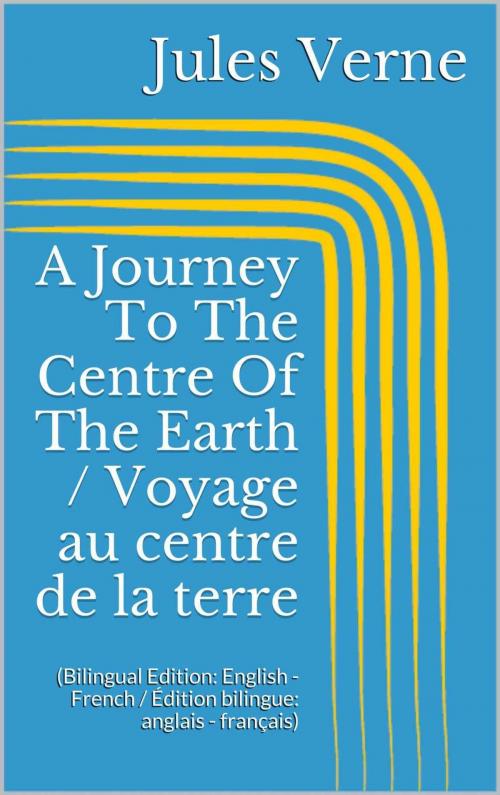A Journey To The Centre Of The Earth / Voyage au centre de la terre
(Bilingual Edition: English - French / Édition bilingue: anglais - français)
Fiction & Literature, Classics| Author: | Jules Verne | ISBN: | 1230000253606 |
| Publisher: | Paperless | Publication: | June 28, 2014 |
| Imprint: | Language: | English |
| Author: | Jules Verne |
| ISBN: | 1230000253606 |
| Publisher: | Paperless |
| Publication: | June 28, 2014 |
| Imprint: | |
| Language: | English |
This edition contains the English translation and the original text in French.
"A Journey to the Center of the Earth" (French: "Voyage au centre de la Terre") is a classic 1864 science fiction novel by Jules Verne. The story involves German professor Otto Lidenbrock who believes there are volcanic tubes going toward the centre of the Earth. He, his nephew Axel, and their guide Hans descend into the Icelandic volcano Snæfellsjökull, encountering many adventures, including prehistoric animals and natural hazards, before eventually coming to the surface again in southern Italy, at the Stromboli volcano. From a scientific point of view, this story has not aged quite as well as other Verne stories, since most of his ideas about what the interior of the Earth contains have since been disproved, but it still manages to captivate audiences when regarded as a classic fantasy novel.
"Voyage au centre de la terre" est un roman de science-fiction, écrit en 1864 par Jules Verne. Il fut publié en édition originale in-18 le 25 novembre 1864, puis en gd in-8° le 13 mai 1867. Le texte de 1867 est différent de celui de 1864. Il comporte en effet deux chapitres de plus (45 au lieu de 43). Ayant découvert un manuscrit runique ancien, un savant, son neveu et leur guide entreprennent un voyage vers le centre de la Terre en y entrant par un volcan islandais éteint, le Sneffels (c'est-à-dire le Snæfellsjökull). Comme à l'habitude de Jules Verne, le roman est un habile mélange de données scientifiques, d'extrapolations osées et d'aventure. L'introduction du roman reflète l'engouement d'alors pour une science jeune, la cryptologie. La suite enchaîne sur une description de l'Islande de la fin du XIXe siècle, puis sur une vaste introduction à deux autres sciences en plein essor, la paléontologie et la géologie (on notera d'ailleurs les divergences entre les interprétations de l'époque et celles couramment admises aujourd'hui).
This edition contains the English translation and the original text in French.
"A Journey to the Center of the Earth" (French: "Voyage au centre de la Terre") is a classic 1864 science fiction novel by Jules Verne. The story involves German professor Otto Lidenbrock who believes there are volcanic tubes going toward the centre of the Earth. He, his nephew Axel, and their guide Hans descend into the Icelandic volcano Snæfellsjökull, encountering many adventures, including prehistoric animals and natural hazards, before eventually coming to the surface again in southern Italy, at the Stromboli volcano. From a scientific point of view, this story has not aged quite as well as other Verne stories, since most of his ideas about what the interior of the Earth contains have since been disproved, but it still manages to captivate audiences when regarded as a classic fantasy novel.
"Voyage au centre de la terre" est un roman de science-fiction, écrit en 1864 par Jules Verne. Il fut publié en édition originale in-18 le 25 novembre 1864, puis en gd in-8° le 13 mai 1867. Le texte de 1867 est différent de celui de 1864. Il comporte en effet deux chapitres de plus (45 au lieu de 43). Ayant découvert un manuscrit runique ancien, un savant, son neveu et leur guide entreprennent un voyage vers le centre de la Terre en y entrant par un volcan islandais éteint, le Sneffels (c'est-à-dire le Snæfellsjökull). Comme à l'habitude de Jules Verne, le roman est un habile mélange de données scientifiques, d'extrapolations osées et d'aventure. L'introduction du roman reflète l'engouement d'alors pour une science jeune, la cryptologie. La suite enchaîne sur une description de l'Islande de la fin du XIXe siècle, puis sur une vaste introduction à deux autres sciences en plein essor, la paléontologie et la géologie (on notera d'ailleurs les divergences entre les interprétations de l'époque et celles couramment admises aujourd'hui).















